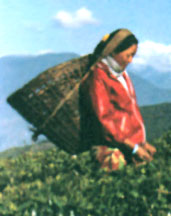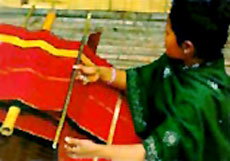Quite a handful of tribal communities have settled down in every nook and corner of the state of Tripura . Lepcha is quite significant amongst them. There are several observations done by the anthropologists of the Indian subcontinent about the culture , tradition , lifestyle etc of these Lepcha tribal community. Today , the The Lepcha tribes are considered to be one of the native people of the state. Interestingly, these Lepcha tribes are belonging to the Mongoloid races just like other tribes of the state.
Thus it becomes only natural that these Lepcha has got similarities in culture with that of the other tribes also. In fact with the tribes, namely, Adi, Apa-Tani, Miri and Mismi, these Lepcha tribes share a very good rapport.
Following the tradition of other tribes also , these Lepcha tribes too are oriented to religion and also to spiritualism. These Lepcha tribes are commonly adept to Buddhists but there are many who also take up to Christianity.
 In order to carry on conversation amongst each other and that with others, these Lepcha tribes use a beautiful Lepcha language, which belongs to the Sino-Tibetan family. Lepcha language has got plenty of monosyllabic traits, which is common in all the other languages of the family group. What is unique about this language is that with this language, restraints in the ambit of vocabulary have aided musical components in it. Also the Lepcha language is `soft` and also `euphonic`. For writing also these Lepcha tribes have developed their individual Lepcha script.
In order to carry on conversation amongst each other and that with others, these Lepcha tribes use a beautiful Lepcha language, which belongs to the Sino-Tibetan family. Lepcha language has got plenty of monosyllabic traits, which is common in all the other languages of the family group. What is unique about this language is that with this language, restraints in the ambit of vocabulary have aided musical components in it. Also the Lepcha language is `soft` and also `euphonic`. For writing also these Lepcha tribes have developed their individual Lepcha script.
In order to sustain their livelihood, these Lepcha tribes have adapted to hunting
Quite a number of Jamatia tribes have taken up the profession of food gathering. Shifting or jhoom cultivation was also in vogue. After clearing all the forest areas every years the Lepchas carried on 2 kinds of dry-land paddy , better known as `Dumbra` and `Ongrey-Zo`. Other products that these Lepcha tribes include `Mongbree`, a kind of millet, and `Kunchung`, or maize eaten in variant forms. `Zo-Mal` or rice was consumed mainly during significant occasions like wedding, house warming.
Festivals and fairs are also an integral part of this Lepcha tribal community. These Lepcha tribes celebrate several festivals like `Nambun`, Lepcha New Year.
Clearing new forest lands every few years the Lepchas cultivated two types of dry-land paddy called `Dumbra` and `Ongrey-Zo`, `Mongbree`, a kind of millet, and `Kunchung`, or maize eaten in different forms, were other main agricultural products. `Zo-Mal` or rice was meant only for important occasions like wedding, house warming and celebrating the `Nambun`, Lepcha New Year.
 Cultural exuberance is rightly being depicted in artistic skills, crafts etc. These Lepcha tribes made a huge variety of exquisite baskets and all the other things require for day-to-day living. . Just like maximum tribal community of the state of Tripura , these Lepcha tribal community, too have got orientation towards and spiritualism.
Cultural exuberance is rightly being depicted in artistic skills, crafts etc. These Lepcha tribes made a huge variety of exquisite baskets and all the other things require for day-to-day living. . Just like maximum tribal community of the state of Tripura , these Lepcha tribal community, too have got orientation towards and spiritualism.
Most Lepcha tribes have been converted to the religion of Buddhism of the Tibetans, which was brought to this country by the Bhutias from the north. However, there are quite a handful of Lepcha tribes who have adapted to Christianity. It is interesting that in spite of the conversion of most of the religions of other alien people, these Lepcha tribes have not yet discarded their indigenous `shamanistic religion`, which is popularly known as Mun. The practice is that these lepcha tribes follow both Bhuddhism and this Mun religion almost side by side.
Societal norms of the Lepcha tribes are same like most of the tribal communities of the Indian subcontinent. The Lepcha tribes follow the rules of patrilinealty. Marriage too has been considered to be the significant institution, like any other Indian tribes. Their marriage customs, are quite alike to that of the Bhutia tribes. Both the families of Lepcha bride and groom fixed the marriage through negotiation. Special rites are being followed that are related to marriage. For example, once the marriage deal is established, the lama will go through the Tibetan calendar in order to match the horoscopes of both the couple and thus plan a suitable date for the marriage. After that, the maternal uncle of the Lepcha male and also some of their relatives, reaches the maternal uncle of the girl with a ritual scarf , called khada . Also they take one rupee, and takes the maternal uncle`s formal consent.
Dresses that these Lepcha tribes wear are very nice and also colorful. Both Lepcha men and women have got unique collection of dresses. A male dress is known as Thokro-Dum.
while a women wear a dress which is named as Dumdyam or Dumvum.
One vital dress which makes a total Thokro-Dum is a white pyjama that goes only upto the `calf` resembling the attire of a Karate sports player. It is almost always `coarse`, rough and quite `durable` appropriate for the living in the open field and dense forests. A Lepcha Dumvum comprises of a dress, which reaches up to the ankle. The female dress is made from soft materials and worn out in the style that looks really stylish.





















